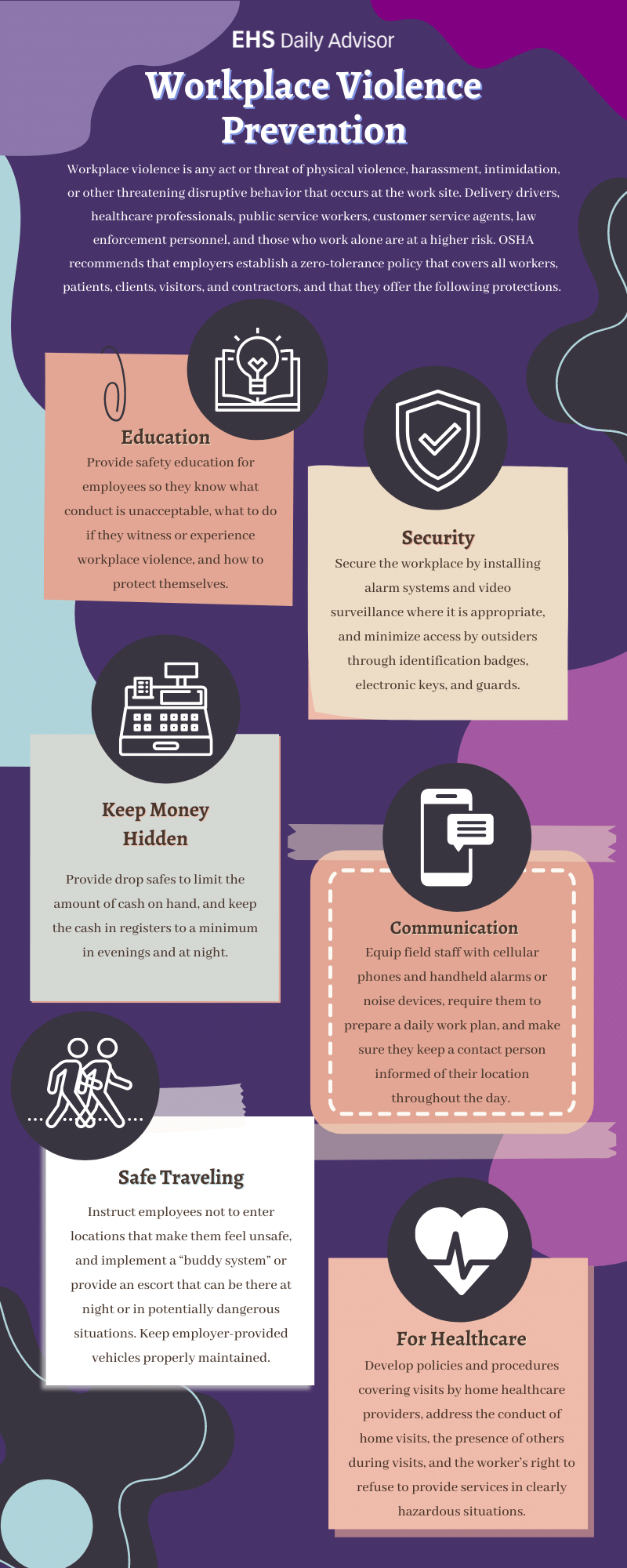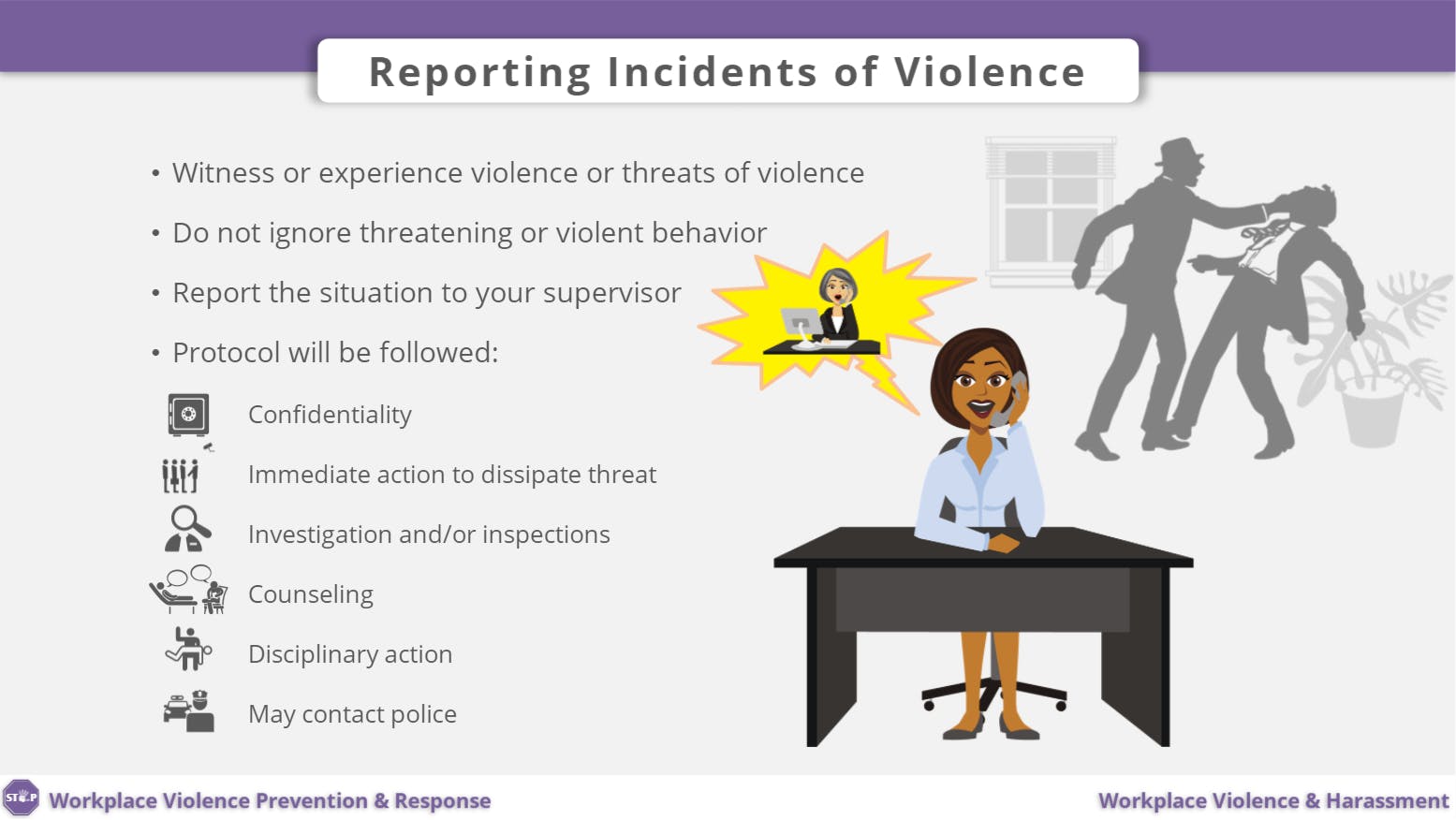An In-depth Guide to Recognizing California Workplace Violence Prevention Regulations
An In-depth Guide to Recognizing California Workplace Violence Prevention Regulations
Blog Article
Examining the Effect of Workplace Society on the Success of Violence Avoidance Efforts and Worker Well-Being
The intersection of workplace culture, violence prevention efforts, and staff member wellness warrants cautious examination, as these elements collectively influence business success. A culture that prioritizes open interaction and psychological safety and security can encourage workers to recognize and report prospective dangers, consequently promoting a setting conducive to both psychological health and efficient violence prevention methods.
Understanding Office Culture
Frequently, workplace culture acts as the structure for employee interactions and overall organizational habits. It incorporates the shared values, beliefs, and methods that shape the environment in which workers run. A favorable office society promotes collaboration, regard, and open communication, while a negative culture may reproduce tension, wonder about, and hostility. Comprehending workplace culture is crucial for organizations aiming to execute effective violence prevention strategies.

Organizations need to examine their present work environment society to determine locations for renovation. This evaluation can entail studies, focus teams, or one-on-one discussions. By recognizing the social characteristics at play, companies can execute targeted interventions that advertise a much safer and more considerate work setting, eventually minimizing the danger of physical violence in the workplace.
Function of Employee Wellness
A favorable workplace culture not only affects organizational habits yet also dramatically impacts employee well-being. When staff members really feel valued and valued, their total task fulfillment boosts, bring about enhanced emotional and psychological wellness. This, consequently, cultivates a sense of belonging and commitment, which is important for lasting engagement and efficiency.
In addition, an encouraging social setting advertises open interaction, enabling staff members to share worries and seek help without anxiety of preconception. This visibility is crucial in resolving issues connected to anxiety, burnout, and social disputes, which can negatively affect both private health and business consistency.
In addition, organizations that prioritize employee wellness often see lowered absence and turn over prices. Healthy and balanced employees are a lot more durable and better furnished to deal with office difficulties, adding to a more stable and productive labor force.
Purchasing employee well-being with efforts such as health cares, psychological wellness sources, and versatile functioning plans can develop a favorable feedback loop, enhancing both private satisfaction and collective business success (california workplace violence prevention). Eventually, focusing on staff member well-being is not just an ethical imperative; it is a tactical approach that profits the whole company
Violence Prevention Strategies
Applying effective physical violence avoidance approaches is critical for preserving a healthy and risk-free workplace setting. Organizations should adopt an extensive approach that includes plan advancement, employee training, and proactive interaction. Developing clear work environment violence plans is the initial action, guaranteeing that all workers understand appropriate actions and the repercussions of offenses.
Training programs need to be developed to educate workers about recognizing indication of possible violence, dispute resolution strategies, and emergency situation action treatments. Regular drills and simulations can boost readiness, promoting a society of recognition and accountability.
Moreover, cultivating open interaction networks urges employees to report concerns without concern of retaliation. This can be facilitated with anonymous reporting systems or regular responses sessions. Moreover, advertising a supportive workplace society that values regard and inclusivity can substantially minimize the risk of physical violence.
Organizations ought to also take part in normal analyses of their workplace society and physical website link violence avoidance methods, adjusting them to developing demands. By prioritizing these methods, business not only protect their staff members yet also boost general well-being, inevitably adding to an extra efficient job setting.
Gauging Cultural Influence
Measuring the effect of workplace culture on violence prevention initiatives is important for comprehending the performance of present approaches and recognizing areas for improvement - california workplace violence prevention. To accomplish this, organizations must use a multifaceted technique that combines qualitative and measurable methods. Surveys and assessments can collect data on employee assumptions of workplace safety and security, assistance, and inclusivity systems, while incident reports supply concrete evidence of physical violence incidents and their context within the organizational culture
Additionally, emphasis groups and meetings can reveal much deeper insights into workers' experiences, beliefs, and perspectives bordering violence avoidance initiatives. Examining this qualitative information aids companies to determine cultural toughness and weak points that may either facilitate or impede reliable prevention techniques. Furthermore, benchmarking against industry standards permits comparative evaluation, assisting organizations assess their efficiency family member to peers.

Developing Encouraging Settings
Regularly fostering a helpful atmosphere within the work environment is crucial for efficient violence avoidance. Such atmospheres empower employees to interact honestly about their experiences and problems, thereby recognizing potential concerns prior to they rise. A culture of support boosts count on among employee, motivating partnership and aggressive analytic.
To develop an encouraging setting, companies must prioritize training programs that focus on conflict resolution, emotional intelligence, and active listening. These abilities gear up employees to manage interpersonal connections constructively, reducing the chance of misunderstandings that can result in violence - california workplace violence prevention. In addition, implementing mentorship programs can provide workers with advice and reassurance, adding to their general well-being
Management plays a critical duty fit a supportive office society. By modeling empathetic behavior and showing a dedication read to worker well-being, leaders set a tone that encourages others to follow suit. Routine responses mechanisms, such as anonymous studies, can additionally help evaluate worker sentiment and emphasize locations for improvement.
Inevitably, an encouraging atmosphere not only minimizes the danger of physical violence but also boosts worker spirits, work contentment, and performance, enhancing the organization's dedication to promoting a secure and flourishing work environment.
Final Thought
A favorable workplace society substantially affects both violence prevention initiatives and employee well-being. By promoting open interaction and urging the reporting of worries, companies can enhance psychological wellness and job fulfillment amongst employees.
The intersection of workplace society, physical violence prevention efforts, website link and staff member health warrants mindful exam, as these aspects jointly affect business success. A society that prioritizes open communication and emotional safety and security can encourage staff members to recognize and report possible threats, thus cultivating an atmosphere conducive to both psychological wellness and reliable physical violence prevention strategies.A favorable work environment society not only influences organizational behavior yet also significantly impacts staff member wellness. Studies and assessments can collect information on worker perceptions of work environment inclusivity, support, and safety systems, while incident reports give concrete proof of violence incidents and their context within the business culture.
A favorable office society substantially affects both violence avoidance efforts and employee well-being.
Report this page